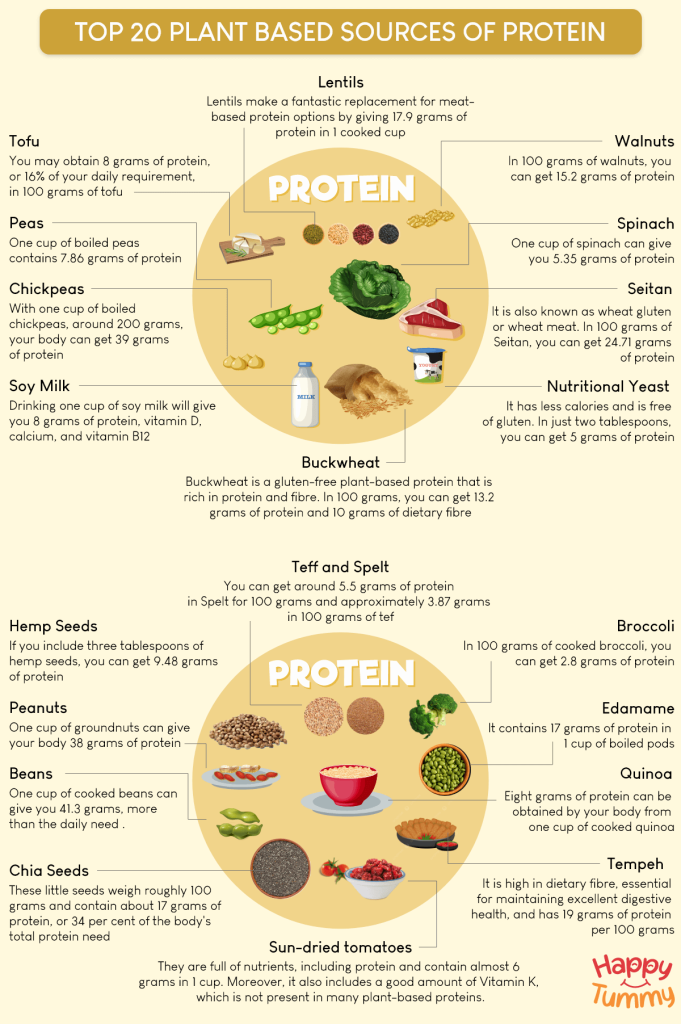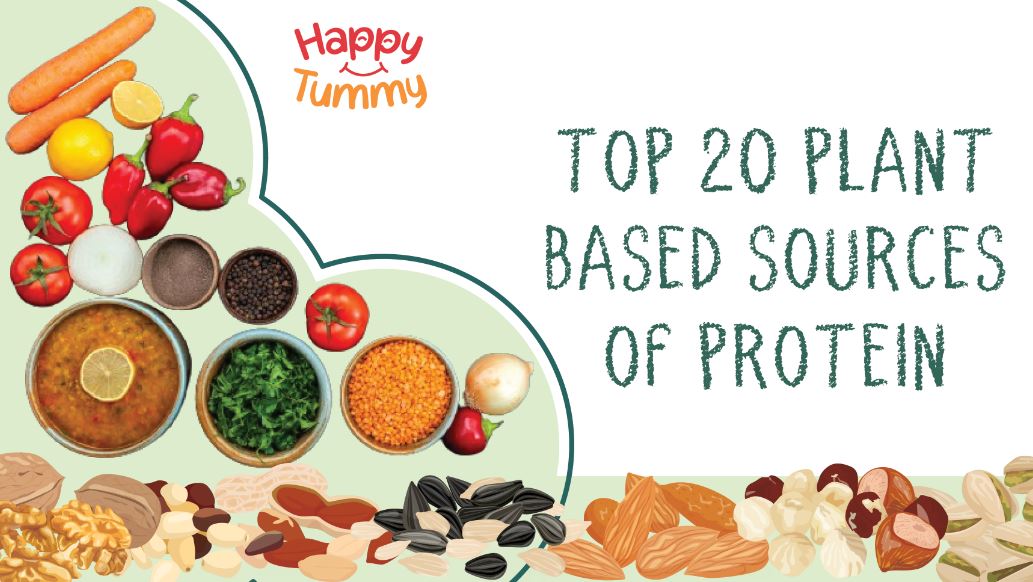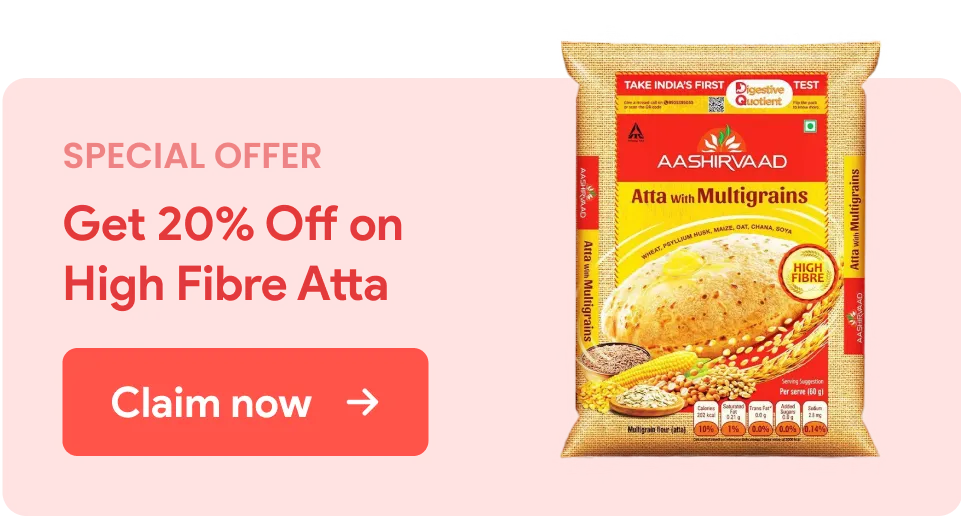Table of Contents
An average adult needs around 50 grams of protein daily [1]. Although it may look like a minimal number, if we review our diet, we will notice more often that we cannot meet this goal. Plant-based protein!
So, does protein only include eggs, chicken, or non-vegetarian food products? The answer, then, is no. As a result of increased understanding and dietary changes, people are now appreciating the benefits of alternative protein sources, like those that come from plants.
The best thing about these plant-based proteins is that they are not just for persons on particular diets; they have several health advantages. Anyone can eat it, vegetarians or vegans alike.
Let’s understand what plant-based proteins are and the top 20 you can include in your diet for healthy benefits.
Protein-Based Proteins – Explained
The proteins found in seeds, grains, legumes, pulses, nuts, and vegetables are known as plant-based proteins. Their increasing popularity can be attributed to their environmentally benign properties and broad use. With increased protein awareness, people opt for these protein sources compared to meat-based.
Top 20 Proteins from Plants
Many people mistakenly believe that there aren’t many proteins in plants generally. They all have enough protein that our bodies can easily use. So, here is our list of the top 20 proteins to start with:

1. Chia Seeds
The tasty seeds of a flowering plant in the mint family are called chia seeds. They are tiny, grey, and speckled with black and white. These little seeds weigh roughly 100 grams and contain about 17 grams of protein, or 34 percent of the body’s total protein need [2].
These seeds are an excellent source of fibre, which, along with protein, is essential for a healthy digestive tract. Using Aashirvaad’s My Meal Plan, you may determine the amount of fibre in chia seeds. It will give you the exact amount in just seconds.
2. Seitan – Plant-based Protein
It is a popular protein for many vegans and vegetarians. Seitan resembles the meat and is unlike your other soy-based mock meats. It is also known as wheat gluten or wheat meat.
In 100 grams of Seitan, you can get 24.71 grams of protein [3]. This ratio makes the richest plant-based proteins in today’s date. It also contains trace amounts of calcium, iron, and phosphorus and is an excellent source of selenium.
However, since gluten is a wheat protein, those who are allergic to gluten should avoid it.
3. Quinoa
Quinoa is a flowering plant that is a member of the amaranth family. Every year, this plant is cultivated for its edible seeds, which are well-known for being high in fibre and protein. Quinoa has become a popular rice substitute due to its many health advantages.
It comes in various colours, including red, white, black, and mixed. Eight grams of protein can be obtained by your body from one cup of cooked quinoa [4]. It is also a complete protein with all the essential amino acids, making it a fantastic substitute for other carbs.
Also read – Health benefits of Quinoa
4. Tofu – Plant-based Protein
Among the best sources of protein are tofu and other soy products. Tofu is low in calories but high in protein and fat. People like it because it contains vitamins, calcium, manganese, and other nutrients.
You may obtain 8 grams of protein, or 16% of your daily requirement, in 100 grams of tofu [5]. It can be used instead of cheese or paneer as it can wonderfully absorb the meal’s flavour when cooked. It can take the place of meat in soups and sandwiches.
5. Tempeh
Tempeh, or Tempe, is a fermented soybean dish from Indonesia. It uses controlled fermentation and natural culturing to bind soybeans into a cake form. A fungus called Rhizopus oligosporus, sometimes referred to as Rhizopus oryzae, is utilized as a tempeh starter during the fermentation process.
Its extensive nutritional profile makes it an extremely beneficial plant-based source of protein. It is high in dietary fibre, essential for maintaining excellent digestive health, and has 19 grams of protein per 100 grams [6]. It also supports good gut flora and is more straightforward to digest.
Take the Aashirvaad digestive quotient test to determine how well your digestive system functions.
6. Lentils – Plant-based Protein
Lentils make a fantastic replacement for meat-based protein options by giving 17.9 grams of protein in 1 cooked cup [7]. You can meet half of your body’s daily protein needs with just one cup of food.
Additionally, the fibre in lentils helps maintain healthy gut flora and beneficial microorganisms. Thus keeping your tummy a happy tummy.
Furthermore, it’s thought that consuming lentils can help with weight loss and lower the risk of diabetes. They are also an excellent source of iron, manganese, folate, antioxidants, and other nutrients that benefit the body’s health.
7. Beans
Every variety of beans across the world is high in protein. One cup of cooked beans can give you 41.3 grams, more than the daily need [8]. They can be a great source of dietary fibre, several plant chemicals, and additional nutrients.
Including beans in your diet can also lower blood pressure, belly fat, and cholesterol. Additionally, they are effective in preserving blood sugar levels.
8. Peas – Plant-based Protein
One of the best plant-based protein sources is the legume family, which includes peas. One cup of boiled peas contains 7.86 grams of protein [9]. Peas are a flexible ingredient that works well in a variety of recipes.
For example, you can add it to other curries and sauces to obtain the protein content even if you don’t like the taste. Additionally, you may purée frozen peas, almonds, mint, and olive oil to serve as a side dish with any meal that doesn’t include meat.
9. Walnuts
Walnuts are a great natural source of protein. These can be added to many dishes or eaten raw. In 100 grams of walnuts, you can get 15.2 grams of protein, which is more than many other sources [10].
Walnut is a very versatile ingredient. You can blend these and make nut butter for your toast. You can also mix them in curd, oats, or smoothies for a healthy breakfast. These can also be included in salads and other dishes.
10. Nutritional Yeast – Plant-based Protein
One of the most incredible vegan protein sources is nutritional yeast, deactivated yeast containing fibre and vitamin B. It tastes nutty and cheesy and can be used in place of vegan cheese.
It has less calories and is free of gluten. Yeast can be mixed into sauces and chutneys or added or sprinkled on popcorn or pasta. You can serve these chutneys with dosa, idli, or even paratha. In just two tablespoons, you can get 5 grams of protein [11].
11. Broccoli– Plant-based Protein
Broccoli is a fantastic vegetable with loads of nutrients and benefits to offer. In 100 grams of cooked broccoli, you can get 2.8 grams of protein [12]. Belonging to the cabbage family, it contains different minerals, vitamins, antioxidants, and fibre, which our body needs.
Consuming broccoli will meet protein requirements, help reduce inflammation, and strengthen immunity. It can also help improve digestion and make your tummy a happy tummy.
Also read – Broccoli Benefits: The Ultimate Guide
12. Teff and Spelt
Wondering what is teff and spelt? Both Spelt and teff belong to the ancient grains category. Some other ancient grains are barley, einkorn, farro, and sorghum. Spelt is a kind of wheat containing gluten, and teff, on the other hand, comes from an annual grass and is gluten-free.
You can get around 5.5 grams of protein in Spelt for 100 grams [13] and approximately 3.87 grams in 100 grams of teff [14]. The protein contained in these ancient grains is much higher than the other ones.
In addition, they both are excellent sources of complex carbs, iron, fibre, manganese, phosphorus, and magnesium. You can also find zinc, Vitamin B, and selenium in these ancient grains.
13. Buckwheat
Buckwheat is a gluten-free plant-based protein that is rich in protein and fibre. In 100 grams, you can get 13.2 grams of protein and 10 grams of dietary fibre [15]. It is a seed that is becoming very popular these days.
People are using these seeds to make buckwheat flour that can be used to make pasta and chapattis. Thus, it is a great replacement for traditional flour and an excellent source for people looking for vegan options.
14. Chickpeas – Plant-based Protein
Most of us will know this food product for its protein richness. Chickpeas is your answer if you want to eat a healthy and protein-rich diet. With one cup of boiled chickpeas, around 200 grams, your body can get 39 grams of protein [16].
The best reason to include them in your diet is that they can be eaten in numerous ways. You can eat them hot or cold and make innumerable recipes. A few examples: use them in curries or stews, and for a healthier option, make hummus and replace it with butter or mayonnaise.
15. Peanuts
Peanuts, the famous Indian winter snack, is another ingredient that is full of protein. One cup of groundnuts can give your body 38 grams of protein, almost equal to what you get from chickpeas [17].
Not only are they full of protein, but they are also healthy fats, which are great for your heart health. You can make peanut butter from peanuts, which is rich in proteins. People on a vegan diet can use it for toast and sandwiches.
Also read – Health benefits of peanuts
16. Hemp Seeds
The Cannabis sativa plant, which is sometimes disparaged for being a member of the same family as the cannabis plant, is the source of hemp seeds. However, there is a minimal amount in hemp seeds of THC, or tetrahydrocannabinol, the compound present in cannabis.
Even though hemp seeds are not as famous as others, they are still a good source of protein. If you include three tablespoons of hemp seeds, you can get 9.48 grams of protein [18]. Moreover, they are excellent iron, magnesium, zinc, calcium, and selenium sources.
And that is not all; these seeds contain Omega-3 and 6 fatty acids necessary for human health. Including them in your diet can also help reduce inflammation, some symptoms of menopause and skin conditions.
17. Soy Milk – Plant-based Protein
Soy milk is a good option for everyone with lactose intolerance. It is an excellent alternative for people who are avoiding dairy products. It contains protein fortified with minerals and vitamins. Drinking one cup of soy milk will give you 8 grams of protein, vitamin D, calcium, and vitamin B12 [19].
Additionally, phytoestrogens included in it assist in lessening menopausal symptoms. It is also a fantastic plant-based source of omega-3 fatty acids.
18. Edamame
If you’re not a big fan of meat alternatives, get your soy meals naturally—straight from the soybean, still in the pod, in the form of edamame. It is a Japanese dish prepared by steaming or boiling the soy pods and serving with other dishes.
Edamame is becoming quite popular these days because of its nutrient value. It contains 17 grams of protein in 1 cup of boiled pods [20]. You can eat it as a snack or appetizer or add it to your salads or pasta.
19. Spinach
Remember that cartoon series, Popeye the Sailor, and how your mothers used to say to eat spinach for strength? Spinach is not only for strength; it is an excellent source of plant-based protein. One cup of spinach can give you 5.35 grams of protein [21].
Not to mention, it is also antioxidant-rich, less in calories, and full of fibre. You can make so much from spinach and include it in your diet. Cook a simple sabzi, make pasta, and add it to your dough to make chappatis or paranthas.
Do you know how to increase your diet’s nutrient and fibre content? Add spinach puree to Aashirvaad multigrain atta, a mix of six grains like wheat, soya, oat, channa, psyllium husk, and maize.
20. Sun-dried tomatoes
One of the most underrated vegetables is sun-dried tomatoes. They are full of nutrients, including protein and contain almost 6 grams in 1 cup [22]. Moreover, it also includes a good amount of Vitamin K, which is not present in many plant-based proteins.
So, next time you make a pizza, add some sun-dried tomatoes for extra taste and nutrients.
Quick Comparison
Let’s quickly compare the protein percentage in the above-mentioned plant-based sources for your reference:
| Sno. | Source | Protein (per 100 grams) |
| 1 | Chia Seeds | 17 grams |
| 2 | Saitan | 75 grams |
| 3 | Quinoa | 8 grams |
| 4 | Tofu | 8 grams |
| 5 | Tempeh | 19 grams |
| 6 | Lentils | 9 grams |
| 7 | Beans | 21 grams |
| 8 | Peas | 5 grams |
| 9 | Walnuts | 15 grams |
| 10 | Nutritional Yeast | 50 grams |
| 11 | Broccoli | 2.8 grams |
| 12 | Teff and Spelt | 3.87 and 15 grams |
| 13 | Buckwheat | 13.2 grams |
| 14 | Chickpeas | 19 grams |
| 15 | Peanuts | 26 grams |
| 16 | Hemp Seeds | 31.6 grams |
| 17 | Soy Milk | 3.3 grams |
| 18 | Edamame | 11 grams |
| 19 | Spinach | 2.9 grams |
| 20 | Sun-dried tomatoes | 5 grams |
Final Thoughts
This article on plant-based protein has only touched the tip of the culinary terrain, which is vast and varied. Each item in the top 20 has not only piqued interest in terms of flavour but also altered the perception of plant-based nutrition.
These include the chameleon-like adaptability of tofu, the nutty robustness of tempeh, and the hearty embrace of seitan. Accept the advantages of these protein-rich miracles and let transitioning to a thriving and healthy plant-based diet continue one delectable bite at a time.
FAQs
Although numerous plant-based protein options exist, tempeh can be considered the best. It contains a good amount of protein and all the essential amino acids the body needs.
To get the right proportion of protein requirement, including a mix and match of food products is necessary. For example, add beans and legumes, nuts, such as almonds and walnuts, and seeds to your diet.
Protein requirements are different depending on age and gender. However, on average, an adult needs around 50 grams of protein in a 2000-calorie diet.
Even though seitan is a healthy and adaptable cuisine, certain people might need to avoid it. For example, seitan includes wheat gluten but is a decent option for those on a soy-free diet. Another common allergy is wheat, which many people must avoid due to gluten-related conditions.
It is a misconception that plant-based proteins are not rich in nutrients. Even though the nutrients may not be as high as in meat-based products, they are still high in numbers and can do wonders for your health.















